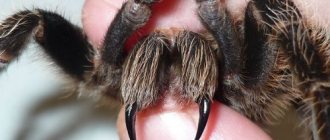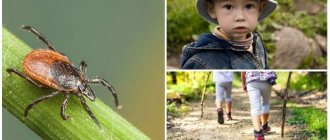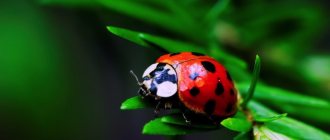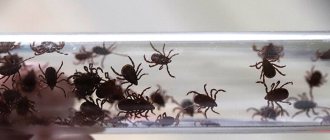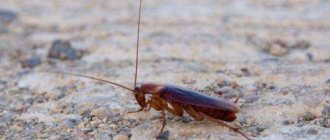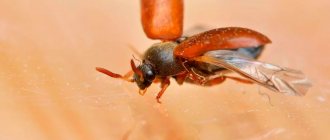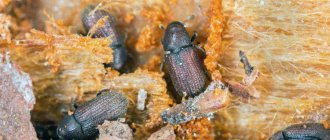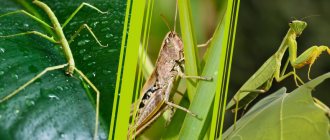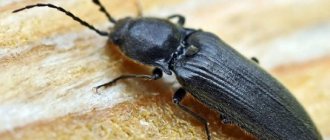Views: 3,117
Insects, despite their small size, are often quite annoying in their neighborhood. Many of them are capable of biting and stinging . Others - attack with a caustic liquid thrown out. Still others are distinguished by the fact that they lay eggs in the body of their victims . This is not a complete list of the damage caused by these arthropods. Even simple insect bites do not always result in painful sensations.
You can read about the problems that insects create in our daily lives here - Insect pests: where is the danger lurking for us? In this article we will talk about those of them that operate in different regions of Russia and nearby areas and with their attacks threaten the life and health of people and animals. We may encounter them at any moment . Therefore, it is necessary to be prepared for an unexpected meeting.
So, we present our list of the ten most dangerous insect bites living near us. We will also consider what the consequences of such an attack and what to do after an arthropod attack.
#10. Ants
ants
. Many perceive them as completely peaceful insects. Hardworking and unobtrusive. However, not all representatives of these creatures are like this. Some are capable of biting and stinging very painfully . At the same time, they do this repeatedly , aggravating the consequences with massive attacks from representatives of the entire anthill. Small, but remote.
African and South American relatives are especially dangerous to health and even to life. But we will talk about exotic aggressors in a separate article. Now we note that our local red ants can also be quite aggressive . However, as a rule, they do not attack without a reason. If you do not touch their home or do not cross their path, then you can completely avoid an attack from these forest inhabitants. It is important to remember that ants can do more than just cause harm. They are natural orderlies both in the wild and in our summer cottages. We examined some of their functions in the article Ants in the garden: benefit or harm?
So, why are red ants dangerous? When they bite, they inject venom containing formic acid and other toxic substances . At a minimum, this causes local pain, swelling, and itching. In more severe cases, headaches, nausea, and allergic reactions may develop. If it gets into the eyes and mucous membranes, ant venom causes irritation.
In addition, like many other insects, ants are capable of transmitting pathogens of dangerous infectious diseases . For example, cholera. Therefore, you need to keep your eyes open with them and be careful when walking through the forest thickets , so as not to inadvertently disturb the measured life of an unnoticed anthill.
Poisonous mushrooms. Pale grebe (Amanita phalloides)
Pale toadstool (lat. Amanita phalloides) is a deadly poisonous mushroom from the genus Amanita (fly agaric).
Pale toadstool is one of the most deadly and poisonous mushrooms. Cases of poisoning do not occur everywhere, but in some cases the mortality rate after poisoning reaches 90%. At a young age, the pale grebe is ovoid and covered with a film. In adulthood, the mushroom has a cap-peduncle fruiting body.
The toadstool's cap can be olive, grayish or greenish. It reaches from five to fifteen centimeters. It can be flat or hemispherical in shape. The edge of the cap is smooth and the surface is wavy. When damaged, the flesh of the toadstool does not change. It is fleshy and white. The pale toadstool mushroom has a mild smell and taste. You can also often find a moire pattern on the leg. If the mushroom is old, it acquires an unpleasant sweetish taste and turns even more grey.
Very often, especially inexperienced mushroom pickers confuse toadstool with russula or champignons. In order not to confuse a dangerous mushroom with delicious delicacies, you need to carefully inspect every centimeter. Champignon plates are pinkish when young, and then lilac. If the plates remain white all the time, these are signs of toadstool. To distinguish a toadstool from a russula, you need to look at the stem: the edible mushroom has no plates.
The poison of this mushroom is so strong that for a person only thirty milligrams of toadstool is enough to cause death. Therefore, even if poisoning is suspected, you should always contact a specialist. Only medical institutions can help cope with the poison. Slowness and self-medication in case of poisoning with the toadstool mushroom is a direct road leading to death.
#9. Midge and biting midges
Small, but extremely unpleasant and annoying insects. Very few people can withstand their invasion. And the whole problem is that they do not attack alone . As a rule, a whole swarm attacks at once . At the same time, aggressors do not hesitate to crawl into the ears, nose, mouth, under clothes, etc.
Midge
Both midges and midges are blood-sucking. Their bites, small, numerous and chaotic, cause unbearable itching and widespread irritation of the skin and mucous membranes . Midges live in abundance in damp, shady forests, especially along rivers. The largest number can be found in June-July. They attack during the day. Maximum activity is observed at moderate temperatures - about 20 degrees.
The midge bites themselves are initially insensitive , because... their saliva contains natural painkillers. However, after the attack, many small itchy red dots remain, causing concern . At the same time, when midges attack, tiny streaks of blood additionally remain on the skin, since when they bite, the insects inject anti-clotting compounds . They prevent blood from clotting, which leads to its protrusion on the surface of the victim’s body. In addition, midges can transmit pathogens of some dangerous diseases : anthrax, onchocerciasis, tularemia and others.
Mokrets
No less problems are caused by biting midges - two-winged insects of very small size (up to 1-2 mm). They are most active in the evening and in the morning, when the sun has not yet broken out. The saliva of biting midges contains toxins that cause dermatitis, swelling, burning and itching . They can transmit filaria parasites - worms that settle in the abdominal or chest cavities of the human or animal body. Japanese encephalitis , tularemia and other diseases also
It is very difficult to escape from these insects, because... they are small and ubiquitous. Therefore, when going out into nature, where biting midges and midges abound, you must take protective repellents with you . Smoke from fires also . In this case, you can add wormwood and other sharp-smelling herbs to the fire. Insects don't like them. In this case, special equipment with protective nets is required when visiting the forest.
Africanized killer bee (Apis mellifera)
But humans themselves contribute to the emergence of dangerous insects. In Brazil, they decided to improve bees, create a more efficient and strong insect, doubling honey production.
In 1956, an Africanized bee was obtained. She is indeed stronger than ordinary bees, reproduces faster and brings more honey, but her aggressiveness is incomparable with ordinary bees. At first, these bees supplanted simple bees, destroying bee colonies. Then they began to intensively guard their territory.
Bee venom is more toxic and allergenic; several stings can put a person in the hospital. But bees do not attack alone. They know how to call for reinforcement with a kind of sound signal. Bees consider up to 5 meters in diameter from the hive their zone and attack any moving object. The attack occurs suddenly, so it is doubly dangerous.
During swarming, bees become doubly aggressive. They not only drive away from the nesting site, but are also ready to chase for a long time any living thing that appears in their habitat. For aggression, bees received an unflattering prefix - “killers.”
#8. Mosquitoes and mosquitoes
Mosquito
Everyone is familiar with mosquitoes. These bloodsuckers are found not only in nature, but also get along quite well in cities - in places where dampness accumulates. More than 50 diseases are known whose causative agents can be transmitted by mosquitoes through a bite. And this list is constantly growing. The malarial mosquito, which spreads malaria, is especially dangerous . In our country, the disease is most common in the central and southern parts of Russia.
In addition to malaria, mosquitoes are capable of transmitting various viral diseases and fevers (for example, yellow fever). Our familiar squeaking mosquito in the Far East is involved in the transmission of Japanese encephalitis . In addition, with an insect bite you can pick up tularemia bacteria and roundworms - parasites that settle in the body of the victim. All diseases are quite serious, affecting the nervous system and internal organs. Many are fatal.
Mosquito
Mosquitoes, unlike mosquitoes, prefer to settle in warmer latitudes . Here they are found in the Caucasus, in Crimea, in the southern zone of Russia. They do not depend for their development on bodies of water, like midges and midges. Therefore, they calmly settle down even in arid areas .
Mosquito bites are extremely irritating and can itch for up to two weeks . With multiple attacks , dermatitis sometimes develops and the temperature rises . The main diseases transmitted by these insects are: visceral leishmaniasis (kala-azar), mosquito fever , bartonellosis , Borovsky's disease (cutaneous leishmaniasis) and others.
#7. Horseflies
Horseflies
Horseflies are similar in appearance to flies. They are called that NOT because their attack causes blindness. Rather, they themselves “go blind” while they feast on the body of the victim. At least while bloodsucking they are much easier to catch . It seems that the insects have forgotten and no longer see the danger in front of them. Although physically everything remains fine with their vision.
Horseflies feed on both blood and plant sap . Their mouthparts are capable of piercing both the integument of animals and the walls of herbaceous vegetation. There are especially many of them in the taiga. Most of them are confined to the banks of rivers . Horseflies most often attack in hot, windless weather . And the hotter the better. For them this is the greatest freedom. However, there are also species of horseflies that are active in cloudy times, when the sky is covered with a dense cover of clouds.
Horseflies drink blood both from blood vessels and by licking it from the surface of the skin . Their saliva has anticoagulant properties. Therefore, it can flow freely from the wound for some time without stopping. The insect bite itself is very sensitive due to the toxic substances contained in the saliva . The most dangerous infections that parasites can transmit are anthrax and tularemia .
Poisonous animals
Poisonous animals are representatives of various classes and species of animals whose bodies constantly or periodically produce substances that are toxic to humans or other species. As a rule, the poison in the bodies of these animals is produced by special venom-carrying apparatuses, which are organs of defense and attack. In some cases, the poison is produced and contained in the tissues of these animals, making them unfit for consumption. The effect of the poison of these animals is of a different nature: its manifestations can vary from slight illness to almost instant death.
Science knows about 5,000 species of poisonous animals from various types. Almost one and a half thousand of them live in the former territory of the USSR. Among poisonous animals, protozoa, mollusks, worms, reptiles, arthropods, amphibians, fish and insects predominate. At the same time, there are only a few species of poisonous mammals in the world: platypuses, skunks, shrews, and gaptooths. Slow lorises are the only genus of known venomous primates. There are also poisonous birds, for example blackbird flycatchers, or pitohui (lat. Pitohui) - a genus of passerine birds from the family of Australian whistlers. The skin and feathers of these birds contain the poison batrachotoxin, the same as that produced by leaf-climbing frogs. It is believed that the poison is necessary for birds to protect themselves from predators. It is possible that the birds are getting toxins from the beetles in their diet.
- St. Petersburg, 1890—1907.
#6. Gadflies
Gadfly
Gadflies, unlike horse flies, do not feed . They have a reduced (i.e. underdeveloped) oral apparatus. Their parasitic significance lies elsewhere. They lay eggs on the skin of humans and animals. Subsequently, the hatching larvae burrow into the skin and develop there , feeding on the surrounding tissues. In one day, the parasite can make a passage 5 cm long in the skin. And in a month, one and a half to two months, one individual gnaws a “road” of about 2 meters . Here's a real horror movie in nature!
In this case, the wounds can become inflamed, fester, and bleed . Damage to the eyes by maggots is especially dangerous. This can lead to blindness. Parasites are removed through surgery . Let us say right away that the spectacle is not for the faint of heart.
#5. Fleas
Flea
Fleas are extremely unpleasant insects. We talked about them and their bites in more detail in the article Consequences of a flea bite. The attacks of these bloodsuckers are painful. Although different people experience flea attacks differently. Saliva is quite poisonous and causes irritation and itching . However, many types of parasites can exist and bite different hosts. This leads to very sad consequences, because... contributes to the transmission of many deadly diseases from animals to humans . For example, the plague.
Plague is cutaneous, pneumonic and bubonic. The most dangerous is pulmonary. A person dies within two or three days in severe agony, accompanied by coughing and pain. In addition to plague, fleas transmit typhus , melioidosis (false glanders), which affects internal organs, tularemia , worm parasites and other diseases.
#4. Bees
Bees
are known as very beneficial insects. However, troubles can also be expected from them. They painfully sting anyone they consider their offenders, injecting a very toxic poison into the victim's body. Bee stings are extremely allergenic . They can provoke a life-threatening allergic reaction. Especially if the insect bite was in the head and neck area.
At the same time, different types of bees differ in aggressiveness . The greatest problems in human history have been caused by the so-called Africanized bees. These insects were brought to South America from Africa to increase honey production. However, the hybrids resulting from crossing local insects with foreigners turned out to be extremely aggressive . Moreover, they attacked not only people and animals, but also their ancestors and weaker fellow tribesmen. So their hordes drove out other relatives from most of the territory of South America.
Our native bees are not as aggressive . However, you can also get a sting with poison from them. The bee itself dies after being stung. Thus, it only stings once. However , this may be enough to inject a fair amount of the toxin into the human blood . The fact is that the sting is connected to the so-called reservoir, which contains poison. And when pierced into the body, the mechanism of repeated contraction of the sting muscles allows every last drop to be introduced into the victim’s body. Therefore, stuck in the skin should be pulled out carefully so as not to contribute to the squeezing of the toxic contents of the reservoir into the body if for some reason it has not had time to empty.
It is worth noting that bees can be provoked not only by careless behavior. They are very sensitive to smells . And if they don’t like the visitor’s aroma, this may trigger an attack. This is how they can react, for example, to the smell of sweat or alcohol. Therefore, you need to be extremely careful with these insects. There are numerous cases of deaths after meeting with them .
Bee venom acts both locally and systemically, that is, at the level of the entire organism. In microdoses, bee toxins have a healing effect. In big ones they kill. For example, about 1000 simultaneous bites of these insects will cause paralysis of the respiratory center in any healthy person .
Lonomy. Caterpillar of the genus Lonomia or “lazy clown” caterpillar (lat. Lonomia Obliqua)
Nature has endowed each animal with its own methods of protection. For some it is excellent camouflage, for others it is sharp teeth and claws, for others it is poison. All the methods of scaring and protection are countless. But it seems that the Lonomia caterpillar is Mother Nature's favorite. How else to explain the fact that its poison has the most powerful known natural toxin. After contact with this caterpillar, a lot of internal bleeding occurs, and bleeding in the brain is also possible. And everyone knows how it ends.
Caterpillar Lonomia Obliqua Caterpillar Lonomia Obliqua
Therefore, when traveling to Southern Brazil, Uruguay, Paraguay and Argentina, be very careful. In the tropical forests of these countries you can meet the dangerous caterpillar Lonomia Obliqua. And it would be okay if only in the forests, but sometimes it can be found in orchards and residential areas.
People would be happy to avoid meeting her, but how can they do this if she is perfectly camouflaged under tree bark or tree moss, and it is very difficult to notice her. The length of the caterpillar reaches 4.5-7 centimeters. Her entire body is covered with branched thorns, reminiscent of Christmas tree branches. Nature has also endowed the lonomia caterpillar with a green-brown color that is ideal for camouflage. There is a white spot on the back that is shaped like the letter “U”.
Each of its thorns can easily pierce human skin. They contain ducts of special glands that secrete poison from the class of anticoagulants (substances that help reduce blood clotting activity and prevent the formation of blood clots). As a result of accidentally touching the caterpillar, these spines instantly pierce the skin and the poison enters the blood. It quickly spreads throughout the body. Therefore, internal bleeding can occur not only in the area of the injection, but also in any other place. The most dangerous thing is that hemorrhages can occur in the brain, as well as in the gastrointestinal tract or in the glomeruli of the kidneys, which leads to the development of acute renal failure. As a result, there is a high probability of death.
Extensive hemorrhages throughout the body
It is surprising that the venom of this caterpillar is the lowest dose of toxicity in the world. It is only 1/1000th of a snake bite. And you can see for yourself what the result is.
The consolation is that such a threat should only be feared for a couple of months a year, until the caterpillar turns into a cute and harmless butterfly from the Saturnia family.
Butterfly of the genus Lonomia
The first widespread case of this hemorrhage syndrome was observed in the state of Rio Grande do Sol, Brazil, among local farmers. Doctors were perplexed as to what caused similar signs of extensive hemorrhages throughout the body in these people. Some of them suffered brain hemorrhage, which led to death.
There are several more sad cases after an unplanned encounter with this caterpillar. Here's one of them. After returning from a vacation in Peru, a young 22-year-old Canadian girl noticed many bruises on her body. She immediately went to the hospital. At first, doctors could not understand what caused so many hemorrhages. But after the patient told them that she had accidentally stepped on 5 small caterpillars with her bare foot, doctors immediately contacted their Brazilian colleagues and an antidote was immediately sent to Canada. But it was already too late. The girl suffered acute renal failure. Death occurred on the 10th day after poisoning.
Disguises as tree moss
In total, over a 5-year period, about 700 cases of poisoning by this caterpillar were recorded in the above state. Every year the number of victims grew. Therefore, scientists from the Butantan Institute in Sao Paulo created an antidote. It turned out to be very effective, the main thing is to introduce it no later than 12-24 hours after contact with the caterpillar.
"Gathering"
So, when going to travel to tropical countries, be very careful and careful. Sometimes ordinary curiosity can play a cruel joke on a person.
#3. Wasps
Wasps
can be either social, living in swarms, or solitary. It is difficult to say which of them is more dangerous. Like bees, wasps that nest together with other relatives protect their home through joint efforts. One wasp, sensing danger, releases a pheromone into the air, provoking its fellow tribesmen to go on the attack . Therefore, mass attacks by these extremely aggressive creatures are not uncommon. And if one wasp sting with poison can be completely survived, then the body of the victims cannot always cope with several “bites”. Such attacks are often fatal .
Moreover, unlike bees, wasps often fly to a person’s home themselves , attracted by sweet fruits or food waste. Insects unceremoniously climb into the most unexpected places, where you least expect to see them. Therefore, in many cases, meeting them is extremely unexpected, and the consequences are almost always unpleasant. An attack by these insects, in addition to painful sensations, just as in the case of bees, can lead to allergic reactions and anaphylactic shock. The poison, penetrating into the blood, damages blood vessels and affects the kidneys . You can learn more about wasp stings here: Why is a wasp sting dangerous?
Wasps are most aggressive in hot weather . Sometimes only the slightest collision with them is enough for the insects to go on the attack. As it gets colder, on the contrary, these angry creatures become passive and apathetic. Therefore, the evening is the best time to fight them and the most suitable moment to get rid of the wasp's nest .
Dangerous bugs
Poisonous beetles that inject poison under the skin after biting are not found in nature. Despite this, there are bugs that suck human blood, and many beetles whose hemolymph contains the dangerous substance cantharidin.
Blister beetles
They leave blisters and abscesses on the body, which is where the name comes from. The poison cantharidin secreted by the beetles is dangerous even without biting the skin. They have an elongated body. which can be painted in black, red, brown stripes. About 150 varieties of this type of beetle live in Russia. They are most common in the forests of Krasnodar.
The body of the blister beetle is saturated with the poison cantharidin, which can cause blisters upon contact with skin.
If cantharidin enters the bloodstream, it can cause serious problems in the functioning of the body. A bitten person may develop liver, kidney, and bladder diseases. In large quantities, the toxic substance poses a mortal danger to humans. It is especially dangerous for children.
If a blister beetle is swallowed, immediate medical attention is required.
Bedbugs
There are about 40 thousand species of bedbugs, distributed throughout the earth. Contrary to the prevailing false belief, bed bugs are far from the only representatives of these unpleasant predatory insects. Examples:
- soldier bug;
- water strider bug;
- bread, beet, cabbage, berry bugs;
- harmful turtle;
- Hottentot bug.
The types of bedbugs are very diverse.
Regardless of the type, bedbugs have excellent sense of touch and a sharp proboscis with which they pierce the skin. These are known bloodsuckers, despite the fact that most species prefer to feed on plant sap. For the purpose of self-defense, they secrete a caustic secretion from their glands, which repels birds and other enemies. They have colors in red, black, brown tones.
How to quickly recognize an insect
Knowing the characteristic signs of dangerous insects, you can try to avoid an attack.
Many of them, such as wasps, bedbugs, horseflies, and hornets, have a recognizable appearance. The rest can be studied from photos and descriptions. Insects that bite humans leave marks on the body:
- redness;
- burning;
- itching;
- tumor;
- rash.
Signs of insect bites
If an allergic reaction is present, the signs may be more obvious, including fainting and death.
Adviсe
The insect sting must be immediately pulled out of the body, otherwise the poison will continue to flow out and spread even more. To prevent it from breaking, you need to try to squeeze it out with clean hands without squeezing. The bitten area is treated with alcohol or soapy water, after which ice is applied to it to relieve pain and prevent swelling.
If an allergic reaction to an insect bite occurs, you should immediately call for medical help. Severe symptoms include shortness of breath, fever, and severe swelling. If measures are not taken in time, a person may die from suffocation.
Immediately after the bite, the sting must be removed and the wound disinfected. There are many types of dangerous insects in Russia, so you need to be prepared to encounter them. While relaxing in the lap of nature, a person can be unexpectedly attacked at any moment. Many insects are dangerous not so much because of their bites, but because of the infections they carry.
What dangerous insects are found in your area? What harm can they cause and how to protect yourself from them? Share your experience in the comments.
#2. Hornets
Hornet
Hornets are social insects. Outwardly they look like wasps. However, they are larger and, as a rule, more aggressive and poisonous. In nature, both wasps and hornets are orderlies . They destroy many harmful insects in large numbers, including aphids, flies, locusts and others. However, there are also reasons to be wary of them.
Attacks by hornets, like bees and wasps close to them, can end tragically not only because of the pain of their bites. After an attack, a person often develops anaphylactic shock , which in the absence of timely medical attention will almost certainly result in death. Hornets and wasps, unlike bees, can sting repeatedly and introduce more and more portions of poison into the victim’s body. Therefore, when they attack, it is important to take refuge as quickly as possible somewhere where the angry insects cannot reach.
The giant Japanese hornet, up to 5 cm long, is especially dangerous ! Its sting reaches 6 mm and can easily and repeatedly pierce the body of a person or animal, poisoning it . On the territory of Russia, this representative of stinging aggressors lives in the eastern part of the country, in the Primorsky Territory. After being stung, severe pain is felt. Sometimes nausea and vomiting, shortness of breath, irregular heartbeat, and paralysis .
Meeting with a ground beetle
The ground beetle is a not very large beetle, black in color. When in danger, it releases a stream of liquid containing poison from the back of its body. The jet flies out at a distance of up to 50 cm. If it comes into contact with open areas of the body, this jet can cause discomfort, severe itching and redness of the body. It is especially dangerous if this jet of poison gets into a person’s eye. If this happens, you should immediately rinse your eyes with running water and, if possible, consult a doctor. Not all representatives of the ground beetle class are poisonous. Dangerous insects live in places with a humid climate, mainly in the south of Russia. Due to its bright colors, the beetle attracts the attention of children, which causes increased danger.
Ground beetle
#1. Ticks - insect bites #1
And finally, ticks. We have already talked about these insects several times. And all because meeting them is both unpleasant and dangerous to health and life . Moreover, during the hunting season, ticks can cause concern to many people throughout the vast territory of both Russia and the whole world.
__________________
You can read more about ticks here:
– Tick-borne encephalitis is the No. 1 disease caused by a tick bite
– Borreliosis – disease No. 2 caused by a tick bite
– Tick-borne diseases No. 3
– Do I need to be vaccinated against ticks?
– How do ixodid ticks attack?
__________________
Mite
A tick bite is usually not felt . Most often you can see it when it begins to swell with blood. Some ticks are capable of causing paralysis with their venom. However, these are not found on Russian territory. Attacks by our domestic parasites pose a greater risk of transmitting pathogens of dangerous diseases . Many of them affect the nervous system, causing irreversible damage to internal organs, making them disabled or even killing.
With a tick bite you can catch numerous types of fevers , typhus , encephalitis , Lyme borreliosis , tularemia and many other diseases. The most famous in our area are the taiga tick, forest tick, dog tick and others.
By
